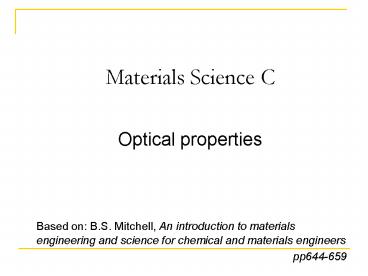Materials Science C PowerPoint PPT Presentation
1 / 18
Title: Materials Science C
1
Materials Science C
- Optical properties
Based on B.S. Mitchell, An introduction to
materials engineering and science for chemical
and materials engineers pp644-659
2
Optical devices
Examples mirrors, lenses, beamsplitters,
photovoltaic devices
3
Optical Properties of Materials
- Interaction of electromagentic radiation (light)
with a material - Absorption
- Reflection
- Transmission
Absorptivity Reflectivity Transmissivity
A material cannot simultaneously be highly
absorptive, reflective and transmissive
4
Optical Properties of Metals and Alloys
- Shininess and inability to transmit visible light
indicates - high absorption
- high reflection
linear absorption coefficient ß
(up to R 1)
ß and R determine how light interacts with a
material
5
Reflectance and color
6
Reflectance and color
- Surface texture
7
Photoelectric effect
- Release of electrons due to absorption of light
energy - potential energy barrier for surface electrons
is finite - critical energy for release f W - Ef
h ?c - below ?c no ejection of photoelectrons
- f characteristic measure
8
Photoelectric effect
- Photoelectric emission depending on wavelength
- optimal emission at ?c
- below ?c insufficient energy
- above ?c decrease of electronic excitations
efficiency
9
Electromagnetic spectrum
10
Optical Properties of ceramics and glasses
- Refractive index n
- velocity of light in vacuum c 299 792 458 m/s
- velocity of light in any other medium v (v lt c)
- refractive index n c/v
11
Refractive index
- Values between ? 1 and ? 4
- air 1.003
- silicate glasses 1.5 to 1.9
- solid oxide ceramics ? 2.7
- Dependent on structure-type and packing geometry
- glasses and cubic crystals n is independent of
direction - other crystal systems n larger in closed-packed
directions - SiO2 glass 1.46, tridymite 1.47,
cristobaltite 1.49 - quartz 1.55
12
Cristalline silicate vs glass
TEM images
Addition of large ions (Pb, Ba) to SiO2
structures increases n significantly
13
Refractive index
- Mechanical distortions of isotopic glasses
changes n - tensile stress lower n normal to direction of
applied stress - compression higher n normal to direction of
applied stress
14
Reflection and refraction
n can be expressed with the angles of incidence
and refraction
15
Absorbance and color
16
Absorbance and color
Absorption of certain wavelength results in color
Generating color in ceramics Addition of
transition elements with incomplete d band
filling V, Cr, Mn, Fe, Co, Ni
17
Light scattering in solids
Some inherently transparent materials appear
milky translucency
- Scattering
- Pores (npore lt nsolid)
- - second-phase particles (SnO2) (n2nd phase gt
nsolid)
18
Summary
- Absorption, Transmission, Reflection
- Origin of colors in metals and ceramics
- Refractive index
- Light scattering

